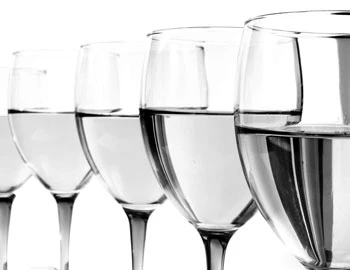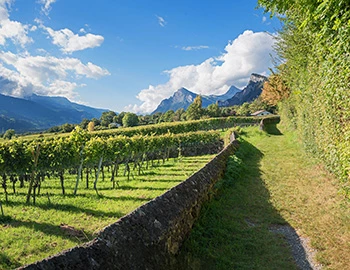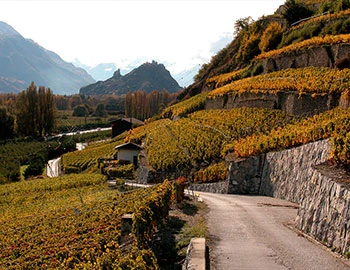Räuschling Rütihof 2022
AOC Zürichsee, Rütihof, 750 ml

| Grape variety: | Räuschling |
| Producer: | Rütihof |
| Origin: | Switzerland / Ostschweiz / Zürich |
| Other vintages: |
Description
The attack is tight, full-bodied and rich. The juicy acidity and a slightly bitter minerality give it a beautiful dynamic. What was perceived in the nose is mirrored in the mouth: grapefruit, kumquat, mandarin and gooseberry completed by some aromatic herbs. The Räuschling is a very ancient grape variety native from Lake Zürich.
Attributes
| Origin: | Switzerland / Ostschweiz / Zürich |
| Grape variety: | Räuschling |
| Label: | Vegan |
| Ripening potential: | 1 to 3 years |
| Drinking temperature: | 10 to 12 °C |
| Food Pairing: | Fresh water fish with cream sauce, Salad with vegetables, pulses, pasta, Goat's cheese, Apéro riche, Mussels au gratin |
| Vinification: | pressed carefully and immediately, fermentation in steel tank, fermentation at low temperatures |
| Harvest: | hand-picking |
| Maturation: | in steel tank |
| Volume: | 12.0 % |
| Note: | Contains sulphites |
Räuschling
History to drink
Räuschling is considered one of the oldest grape cultivars in the world. While it is only certain that it was already cultivated in Roman times, it can be assumed the variety developed from wild vines already present in Switzerland.
Its first written mention was in 1614, in the Weingartenordnung (vineyard regulation) by Philipp Ernst, Count of Hohenlohe-Neuenstein.
Räuschling currently grows on 20 hectares in Switzerland, 12 of which are in the area around Lake Zurich, its ideal climatic environment.
Like most vines, the longstanding Räuschling has many synonyms. But no other variety, has such original and diverse examples. Here are some of them: brauner Nürnberger, Buchelin, Divishna-vizhna, Dretsch, Drötsch, Dünnelbling, Erjava Tizhna, Frankentraube, Gros fendant, Grünspat, Guay Jaune, Heinzler, Klaffer, Klöpfer, Luttenberger, Luttenbergerstock, Luttenbershna, Lyonnaise Blanche, Melon Blanc, Offenburger, Padebecker, Pfäffling, Pfaffentraube, Rüssling, Silberweiss, Thunerrebe, Weisser Kläpfer, Zürirebe, Züriwiss ... and that is only a small selection!

Räuschling
History to drink
Räuschling is considered one of the oldest grape cultivars in the world. While it is only certain that it was already cultivated in Roman times, it can be assumed the variety developed from wild vines already present in Switzerland.
Its first written mention was in 1614, in the Weingartenordnung (vineyard regulation) by Philipp Ernst, Count of Hohenlohe-Neuenstein.
Räuschling currently grows on 20 hectares in Switzerland, 12 of which are in the area around Lake Zurich, its ideal climatic environment.
Like most vines, the longstanding Räuschling has many synonyms. But no other variety, has such original and diverse examples. Here are some of them: brauner Nürnberger, Buchelin, Divishna-vizhna, Dretsch, Drötsch, Dünnelbling, Erjava Tizhna, Frankentraube, Gros fendant, Grünspat, Guay Jaune, Heinzler, Klaffer, Klöpfer, Luttenberger, Luttenbergerstock, Luttenbershna, Lyonnaise Blanche, Melon Blanc, Offenburger, Padebecker, Pfäffling, Pfaffentraube, Rüssling, Silberweiss, Thunerrebe, Weisser Kläpfer, Zürirebe, Züriwiss ... and that is only a small selection!

Zürich
Zurich: On the way to the top
With a cultivated area of 620 hectares, Zurich is the largest wine-producing canton in German-speaking Switzerland. The potential is great at prime locations on Lake Zurich and in the various river valleys. It is no surprise that a steadily increasing number of top wines are vinified here. The major variety is Pinot Noir. But white varieties also exceed exquisitely, such as Müller-Thurgau and the long-established Räuschling, as well as international varieties like Chardonnay and Sauvignon Blanc. The wine-producing canton of Zurich is currently experiencing the most sustained upswing in quality in its history.

Ostschweiz
Eastern Switzerland: an intriguing puzzle
Eastern Switzerland has long been positioned on the northern rim of the climate zone where the cultivation of popular Swiss varieties is possible. Due to a warming climate, the vineyards of Aargau, Zurich, Schaffhausen, Thurgau and Graubünden are now in the zone where varieties such as Müller-Thurgau or Pinot Noir succeed excellently. But even long-established, almost-forgotten varieties such as Elbling, Räuschling and Completer are experiencing a renaissance.

Switzerland
Switzerland – A small country with enormous diversity
Switzerland is famous for its banks, watches, and cheese, but not necessarily for its wine. The Swiss didn't invent wine, but they have been extremely open and curious to it. Wine culture arrived in what is now modern Switzerland via several routes: from Marseilles to Lake Geneva and the Lower Valais region; from the Aosta Valley through the Great St. Bernard Pass to the rest of Valais; from the Rhone through Burgundy, across the Jura Mountains to Lake Constance; and from Lombardy to Ticino, and then on to Grisons.



